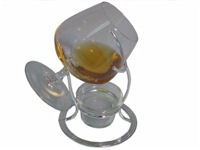Armagnac, Brandy & Cognac Bios
What is the difference between Armagnac, Cognac, and indeed French Brandy?
First and foremost, both Armagnac and Cognac are "Appellation Controllee" which means that any product carrying the name has to come from a defined geographic area, and be made according to strict rules to ensure conformity and quality.
For Armagnac this is an area on the Southwest of France mainly in the Gers and Gascony, between Bordeaux and the Landes forests and the Pyrenees.
Cognac is made further north of Bordeaux around the Charentes river. The grape varieties used tend to be different, but the other distinguising feature of Armagnac is that it is produced using a continuous still process. This tends to yield a spirit which is richer in aroma-containing impurities - it is after all the impurities which give a brandy character. Hence Armagnac tends to be more "fragrant" than Cognac, although Cognac will tend to be more elegant and cleaner in taste.
In truth it is difficult to claim that one is better than the other - they are different in style and people may well have favourites in both styles.
There is also a difference in the history. Cognac was largely developed by entrepreneurs such as Hennessy (Irish), Courvoisier, Remy Martin, and Martell, names which are big brands in themselves. In Armagnac however, production was and is a more rural artisan affair - small producers spread over quite a large geographical area - so there are few big brands of Armagnac.
French brandy however can be produced anywhere in France, and is applied to any grape-based spirit distilled from wine. These tend to be less refined, but cheaper and depending on the need (e.g. for cooking or cocktails) they can be great value for money. See The Cheese and Wine Shops range of Armagnacs, Cognacs and Brandies here
A continuous still does, as the name suggests, sustain a constant process of distillation. This along with the higher alcohol concentration of the final distillate is its main advantage over a pot still which can only work in batches. Continuous stills are charged with pre-heated feed liquor at some point in the column. Heat (usually in the form of steam) is supplied to the base of the column. Stripped (alcohol free) liquid is drawn off at the base while almost pure alcohol is condensed after migrating to the top of the column.
What is Brandy? In simple words, Brandy is distilled wine. The name is derived from the Dutch word brandewijn meaning burnt wine. Brandy is typically made from grapes but other fruits are also widely used. Brandy is by default made of grape unless specified.
Most often had as an after-dinner drink, it has an alcohol content of 40% - 50% alcohol by volume. Based on the main ingredient or flavour used, and where it comes from, brandy can be broadly classified into 3 types:
Grape Brandy:
Made by distilling fermented grape juice (wine).
American Mostly from
Armagnac Being the first spirit to be distilled in
Brandy de Jerez Available on its own or used as an additive for sherry, it is a brandy from
Lourinha Comes from the
South African Made as in
Aguardente Means burning water, as known in countries like
Pomace Brandy:
Made from the left over pulp, skin, seeds and stems of wine production. It is known by different names in different places.
Lozovaka (loza)
Zivania
Marc
Chacha Georgia.
Tresterbrand
Tsipouro
Torkoly
Grappa
Grozdova
Aguardente Portuguese.
Orujo
Fruit Brandy: Also known as Eau de Vie.
Various fruits and flavours can be used.
Calvados Apple brandy from Lower Normandy region of
Kirshwasser Made with cherries.
Palinka Traditional Hungarian brandy. Made using a variety of fruits like plum (szilva), apricot (barrack), grape (tφrkφly), elderberry (bodza), pear (vilmoskφrte), cherry (cseresznye), and there are the rare ones like apple, peach, and even walnut (dio). Even a mixed fruit palinka known as Vegyes, is popular.
Slivovitz/Rakia Conventional to
Slivovice A plum brandy with a standard of 52% alcoholic strength set by law. Distinctive to places like
Schnapps/Snaps Usually good with meals owing to the light bodied structure. Mainly German or Austrian, often as a fruit brandy liqueur.
Tuica (tzuika) Made from either or a combination of fruits like plums, apples, pears, apricots, mulberries, peaches, and quinces. It is a clear brandy from
Himbeergist Coming from the region of
Liqueurs that use brandy as a base:
Benedictine Ratafia Kajmir Tuaca Advocaat Chambord Liqueur Royale de France Crθme de violette Grand Marnier Pineau de charantes Hpnotiq Kruskovac Lichido Triple Sec













